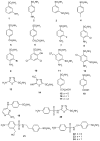Sulfonamide Inhibition Studies of a New β-Carbonic Anhydrase from the Pathogenic Protozoan Entamoeba histolytica
- PMID: 30544802
- PMCID: PMC6321117
- DOI: 10.3390/ijms19123946
Sulfonamide Inhibition Studies of a New β-Carbonic Anhydrase from the Pathogenic Protozoan Entamoeba histolytica
Abstract
A newly described β-carbonic anhydrase (CA, EC 4.2.1.1) from the pathogenic protozoan Entamoeba histolytica, EhiCA, was recently shown to possess a significant catalytic activity for the physiologic CO₂ hydration reaction (kcat of 6.7 × 10⁵ s-1 and a kcat/Km of 8.9 × 10⁷ M-1 s-1). A panel of sulphonamides and one sulfamate, some of which are clinically used drugs, were investigated for their inhibitory properties against EhiCA. The best inhibitors detected in the study were 4-hydroxymethyl/ethyl-benzenesulfonamide (KIs of 36⁻89 nM), whereas some sulfanilyl-sulfonamides showed activities in the range of 285⁻331 nM. Acetazolamide, methazolamide, ethoxzolamide, and dichlorophenamide were less effective inhibitors (KIs of 509⁻845 nM) compared to other sulfonamides investigated here. As β-CAs are not present in vertebrates, the present study may be useful for detecting lead compounds for the design of more effective inhibitors with potential to develop anti-infectives with alternative mechanisms of action.
Keywords: Entamoeba histolytica; carbonic anhydrase; inhibitor; metalloenzymes; protozoan; sulfamates; sulfonamides.
Conflict of interest statement
The authors do not declare conflict of interest.
Figures



Similar articles
-
Cloning, Characterization and Anion Inhibition Studies of a β-Carbonic Anhydrase from the Pathogenic Protozoan Entamoeba histolytica.Molecules. 2018 Nov 28;23(12):3112. doi: 10.3390/molecules23123112. Molecules. 2018. PMID: 30486513 Free PMC article.
-
Sulfonamide inhibition studies of two β-carbonic anhydrases from the bacterial pathogen Legionella pneumophila.Bioorg Med Chem. 2014 Jun 1;22(11):2939-46. doi: 10.1016/j.bmc.2014.04.006. Epub 2014 Apr 13. Bioorg Med Chem. 2014. PMID: 24792813
-
Carbonic anhydrase inhibitors: cloning and sulfonamide inhibition studies of a carboxyterminal truncated alpha-carbonic anhydrase from Helicobacter pylori.Bioorg Med Chem Lett. 2006 Apr 15;16(8):2182-8. doi: 10.1016/j.bmcl.2006.01.044. Epub 2006 Feb 3. Bioorg Med Chem Lett. 2006. PMID: 16459077
-
Saccharomyces cerevisiae β-carbonic anhydrase: inhibition and activation studies.Curr Pharm Des. 2010;16(29):3327-36. doi: 10.2174/138161210793429878. Curr Pharm Des. 2010. PMID: 20819061 Review.
-
Identification and inhibition of carbonic anhydrases from nematodes.J Enzyme Inhib Med Chem. 2016;31(sup4):176-184. doi: 10.1080/14756366.2016.1221826. Epub 2016 Aug 25. J Enzyme Inhib Med Chem. 2016. PMID: 27557594 Review.
Cited by
-
Cloning, characterization, and inhibition of the novel β-carbonic anhydrase from parasitic blood fluke, Schistosoma mansoni.J Enzyme Inhib Med Chem. 2023 Dec;38(1):2184299. doi: 10.1080/14756366.2023.2184299. J Enzyme Inhib Med Chem. 2023. PMID: 36856011 Free PMC article.
-
Activation Studies of the β-Carbonic Anhydrase from the Pathogenic Protozoan Entamoeba histolytica with Amino Acids and Amines.Metabolites. 2019 Feb 1;9(2):26. doi: 10.3390/metabo9020026. Metabolites. 2019. PMID: 30717275 Free PMC article.
-
Phytochemicals as Modulators of Long Non-Coding RNAs and Inhibitors of Cancer-Related Carbonic Anhydrases.Int J Mol Sci. 2019 Jun 15;20(12):2939. doi: 10.3390/ijms20122939. Int J Mol Sci. 2019. PMID: 31208095 Free PMC article. Review.
-
Advances in the Development of Carbonic Anhydrase Inhibitors as New Antiprotozoal Agents.Curr Med Chem. 2024;31(41):6735-6759. doi: 10.2174/0109298673249553231018070920. Curr Med Chem. 2024. PMID: 37909441 Review.
-
Mycobacterium tuberculosis β-Carbonic Anhydrases: Novel Targets for Developing Antituberculosis Drugs.Int J Mol Sci. 2019 Oct 17;20(20):5153. doi: 10.3390/ijms20205153. Int J Mol Sci. 2019. PMID: 31627429 Free PMC article. Review.
References
-
- Costa J.O., Resende J.A., Gil F.F., Santos J.F.G., Gomes M.A. Prevalence of Entamoeba histolytica and other enteral parasitic diseases in the metropolitan region of Belo Horizonte, Brazil. A cross-sectional study. Sao Paulo Med. J. 2018;136:319–323. doi: 10.1590/1516-3180.2018.0036170418. - DOI - PMC - PubMed
MeSH terms
Substances
LinkOut - more resources
Full Text Sources
Research Materials
Miscellaneous

